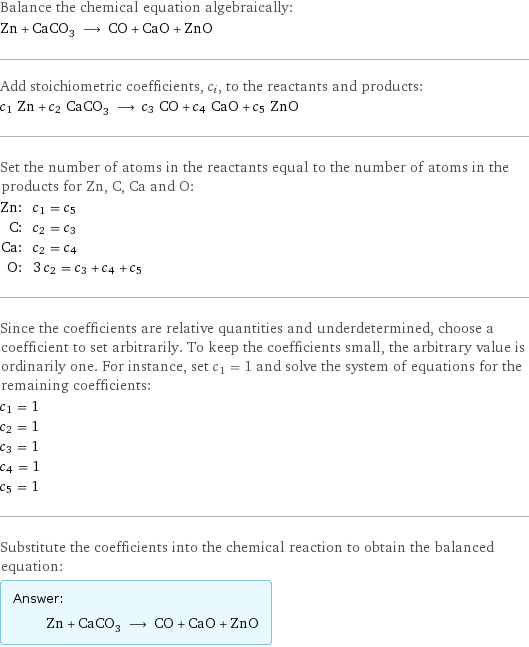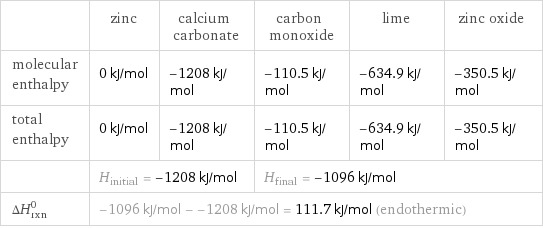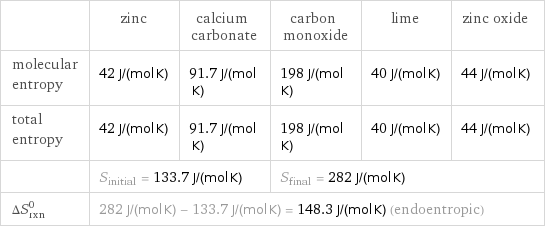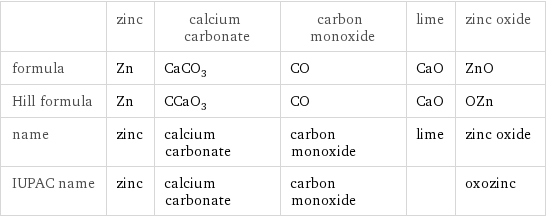Input interpretation

Zn zinc + CaCO_3 calcium carbonate ⟶ CO carbon monoxide + CaO lime + ZnO zinc oxide
Balanced equation

Balance the chemical equation algebraically: Zn + CaCO_3 ⟶ CO + CaO + ZnO Add stoichiometric coefficients, c_i, to the reactants and products: c_1 Zn + c_2 CaCO_3 ⟶ c_3 CO + c_4 CaO + c_5 ZnO Set the number of atoms in the reactants equal to the number of atoms in the products for Zn, C, Ca and O: Zn: | c_1 = c_5 C: | c_2 = c_3 Ca: | c_2 = c_4 O: | 3 c_2 = c_3 + c_4 + c_5 Since the coefficients are relative quantities and underdetermined, choose a coefficient to set arbitrarily. To keep the coefficients small, the arbitrary value is ordinarily one. For instance, set c_1 = 1 and solve the system of equations for the remaining coefficients: c_1 = 1 c_2 = 1 c_3 = 1 c_4 = 1 c_5 = 1 Substitute the coefficients into the chemical reaction to obtain the balanced equation: Answer: | | Zn + CaCO_3 ⟶ CO + CaO + ZnO
Structures

+ ⟶ + +
Names

zinc + calcium carbonate ⟶ carbon monoxide + lime + zinc oxide
Reaction thermodynamics
Enthalpy

| zinc | calcium carbonate | carbon monoxide | lime | zinc oxide molecular enthalpy | 0 kJ/mol | -1208 kJ/mol | -110.5 kJ/mol | -634.9 kJ/mol | -350.5 kJ/mol total enthalpy | 0 kJ/mol | -1208 kJ/mol | -110.5 kJ/mol | -634.9 kJ/mol | -350.5 kJ/mol | H_initial = -1208 kJ/mol | | H_final = -1096 kJ/mol | | ΔH_rxn^0 | -1096 kJ/mol - -1208 kJ/mol = 111.7 kJ/mol (endothermic) | | | |
Entropy

| zinc | calcium carbonate | carbon monoxide | lime | zinc oxide molecular entropy | 42 J/(mol K) | 91.7 J/(mol K) | 198 J/(mol K) | 40 J/(mol K) | 44 J/(mol K) total entropy | 42 J/(mol K) | 91.7 J/(mol K) | 198 J/(mol K) | 40 J/(mol K) | 44 J/(mol K) | S_initial = 133.7 J/(mol K) | | S_final = 282 J/(mol K) | | ΔS_rxn^0 | 282 J/(mol K) - 133.7 J/(mol K) = 148.3 J/(mol K) (endoentropic) | | | |
Equilibrium constant
![Construct the equilibrium constant, K, expression for: Zn + CaCO_3 ⟶ CO + CaO + ZnO Plan: • Balance the chemical equation. • Determine the stoichiometric numbers. • Assemble the activity expression for each chemical species. • Use the activity expressions to build the equilibrium constant expression. Write the balanced chemical equation: Zn + CaCO_3 ⟶ CO + CaO + ZnO Assign stoichiometric numbers, ν_i, using the stoichiometric coefficients, c_i, from the balanced chemical equation in the following manner: ν_i = -c_i for reactants and ν_i = c_i for products: chemical species | c_i | ν_i Zn | 1 | -1 CaCO_3 | 1 | -1 CO | 1 | 1 CaO | 1 | 1 ZnO | 1 | 1 Assemble the activity expressions accounting for the state of matter and ν_i: chemical species | c_i | ν_i | activity expression Zn | 1 | -1 | ([Zn])^(-1) CaCO_3 | 1 | -1 | ([CaCO3])^(-1) CO | 1 | 1 | [CO] CaO | 1 | 1 | [CaO] ZnO | 1 | 1 | [ZnO] The equilibrium constant symbol in the concentration basis is: K_c Mulitply the activity expressions to arrive at the K_c expression: Answer: | | K_c = ([Zn])^(-1) ([CaCO3])^(-1) [CO] [CaO] [ZnO] = ([CO] [CaO] [ZnO])/([Zn] [CaCO3])](../image_source/50d931464e213bc597ed3262d2986c7e.png)
Construct the equilibrium constant, K, expression for: Zn + CaCO_3 ⟶ CO + CaO + ZnO Plan: • Balance the chemical equation. • Determine the stoichiometric numbers. • Assemble the activity expression for each chemical species. • Use the activity expressions to build the equilibrium constant expression. Write the balanced chemical equation: Zn + CaCO_3 ⟶ CO + CaO + ZnO Assign stoichiometric numbers, ν_i, using the stoichiometric coefficients, c_i, from the balanced chemical equation in the following manner: ν_i = -c_i for reactants and ν_i = c_i for products: chemical species | c_i | ν_i Zn | 1 | -1 CaCO_3 | 1 | -1 CO | 1 | 1 CaO | 1 | 1 ZnO | 1 | 1 Assemble the activity expressions accounting for the state of matter and ν_i: chemical species | c_i | ν_i | activity expression Zn | 1 | -1 | ([Zn])^(-1) CaCO_3 | 1 | -1 | ([CaCO3])^(-1) CO | 1 | 1 | [CO] CaO | 1 | 1 | [CaO] ZnO | 1 | 1 | [ZnO] The equilibrium constant symbol in the concentration basis is: K_c Mulitply the activity expressions to arrive at the K_c expression: Answer: | | K_c = ([Zn])^(-1) ([CaCO3])^(-1) [CO] [CaO] [ZnO] = ([CO] [CaO] [ZnO])/([Zn] [CaCO3])
Rate of reaction
![Construct the rate of reaction expression for: Zn + CaCO_3 ⟶ CO + CaO + ZnO Plan: • Balance the chemical equation. • Determine the stoichiometric numbers. • Assemble the rate term for each chemical species. • Write the rate of reaction expression. Write the balanced chemical equation: Zn + CaCO_3 ⟶ CO + CaO + ZnO Assign stoichiometric numbers, ν_i, using the stoichiometric coefficients, c_i, from the balanced chemical equation in the following manner: ν_i = -c_i for reactants and ν_i = c_i for products: chemical species | c_i | ν_i Zn | 1 | -1 CaCO_3 | 1 | -1 CO | 1 | 1 CaO | 1 | 1 ZnO | 1 | 1 The rate term for each chemical species, B_i, is 1/ν_i(Δ[B_i])/(Δt) where [B_i] is the amount concentration and t is time: chemical species | c_i | ν_i | rate term Zn | 1 | -1 | -(Δ[Zn])/(Δt) CaCO_3 | 1 | -1 | -(Δ[CaCO3])/(Δt) CO | 1 | 1 | (Δ[CO])/(Δt) CaO | 1 | 1 | (Δ[CaO])/(Δt) ZnO | 1 | 1 | (Δ[ZnO])/(Δt) (for infinitesimal rate of change, replace Δ with d) Set the rate terms equal to each other to arrive at the rate expression: Answer: | | rate = -(Δ[Zn])/(Δt) = -(Δ[CaCO3])/(Δt) = (Δ[CO])/(Δt) = (Δ[CaO])/(Δt) = (Δ[ZnO])/(Δt) (assuming constant volume and no accumulation of intermediates or side products)](../image_source/e98e69ae7231f894d6928cd05805ff1d.png)
Construct the rate of reaction expression for: Zn + CaCO_3 ⟶ CO + CaO + ZnO Plan: • Balance the chemical equation. • Determine the stoichiometric numbers. • Assemble the rate term for each chemical species. • Write the rate of reaction expression. Write the balanced chemical equation: Zn + CaCO_3 ⟶ CO + CaO + ZnO Assign stoichiometric numbers, ν_i, using the stoichiometric coefficients, c_i, from the balanced chemical equation in the following manner: ν_i = -c_i for reactants and ν_i = c_i for products: chemical species | c_i | ν_i Zn | 1 | -1 CaCO_3 | 1 | -1 CO | 1 | 1 CaO | 1 | 1 ZnO | 1 | 1 The rate term for each chemical species, B_i, is 1/ν_i(Δ[B_i])/(Δt) where [B_i] is the amount concentration and t is time: chemical species | c_i | ν_i | rate term Zn | 1 | -1 | -(Δ[Zn])/(Δt) CaCO_3 | 1 | -1 | -(Δ[CaCO3])/(Δt) CO | 1 | 1 | (Δ[CO])/(Δt) CaO | 1 | 1 | (Δ[CaO])/(Δt) ZnO | 1 | 1 | (Δ[ZnO])/(Δt) (for infinitesimal rate of change, replace Δ with d) Set the rate terms equal to each other to arrive at the rate expression: Answer: | | rate = -(Δ[Zn])/(Δt) = -(Δ[CaCO3])/(Δt) = (Δ[CO])/(Δt) = (Δ[CaO])/(Δt) = (Δ[ZnO])/(Δt) (assuming constant volume and no accumulation of intermediates or side products)
Chemical names and formulas

| zinc | calcium carbonate | carbon monoxide | lime | zinc oxide formula | Zn | CaCO_3 | CO | CaO | ZnO Hill formula | Zn | CCaO_3 | CO | CaO | OZn name | zinc | calcium carbonate | carbon monoxide | lime | zinc oxide IUPAC name | zinc | calcium carbonate | carbon monoxide | | oxozinc
Substance properties

| zinc | calcium carbonate | carbon monoxide | lime | zinc oxide molar mass | 65.38 g/mol | 100.09 g/mol | 28.01 g/mol | 56.077 g/mol | 81.38 g/mol phase | solid (at STP) | solid (at STP) | gas (at STP) | solid (at STP) | solid (at STP) melting point | 420 °C | 1340 °C | -205 °C | 2580 °C | 1975 °C boiling point | 907 °C | | -191.5 °C | 2850 °C | 2360 °C density | 7.14 g/cm^3 | 2.71 g/cm^3 | 0.001145 g/cm^3 (at 25 °C) | 3.3 g/cm^3 | 5.6 g/cm^3 solubility in water | insoluble | insoluble | | reacts | dynamic viscosity | | | 1.772×10^-5 Pa s (at 25 °C) | | odor | odorless | | odorless | | odorless
Units
